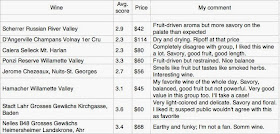 |
| German Pinots stand tall |
32 wines were tasted in San Francisco: 2 from each region from 2007, '08, '09 and '10. The tasters were 17 sommeliers, some well known, and two writers, Jordan Mackay and myself.
The Germans swept 2009, placing 1st and 2nd. In fact, 2009 Stadt Lahr Grosses Gewächs Kirchgasse Baden Spätburgunder had the highest average rating of all 32. (Buy it here.)
A German Pinot also tied for second in 2010. At the same time, two German wines came in last in their group, one in 2010 and one (tied) in 2007.
Still, it was an impressive performance for German Pinot Noir, aka Spätburgunder, that no doubt was the point of the organizers, Tom Elliot of the importer Northwest Wines and celebrity sommelier Raj Parr.
The contest wasn't rigged. Many wines were personal favorites provided by the sommeliers. From Burgundy, for example, there were four 1er Crus and a Grand Cru.
The non-German wines weren't cheap either, with a median price of $75. Germany also did well on value, with a median price of $57.
 |
| Eric Hamacher (left) made my favorite Pinot |
The region that confused everyone was Willamette Valley; not one of the 8 Willamette Pinots was correctly identified by half the tasters.
My own favorite wine of the event was 2009 Hamacher Willamette Valley, a relative bargain you can buy for $40, such as from this shop. But I thought it was Burgundy.
The somms were good at calling Burgundy and California, getting 6 of 8 right as a group for both. Perhaps not surprisingly, the consensus was correct on only one of the German wines.
It's worth mentioning that somms as a group have different tastes than wine critics, or the general public. Most of the wines brought to the tasting were quite light-bodied, though they were more fruit-driven than I might have expected.
Still, if Elliot's point was to prove that German Pinot Noirs can sit comfortably on a wine list amid some of the best Pinot Noirs from the rest of the world, he succeeded. Now if only they weren't called Spätburgunder Rotwein.
Here are all the results. Wines were scored between 1 and 5, with 5 being the best.
2007 vintage
2008 vintage
2009 vintage
2010 vintage
Follow me on Twitter: @wblakegray and like The Gray Report on Facebook.




Ohh man... You are going to lose your membership to the AFWE (if you have one) with these notes! ;-)
ReplyDeleteI don't even know what it stands for, so I can't be a member. I am a card-carrying member of the Lost Weekend DVD rental store.
ReplyDeleteAnti Flavor Wine Elite, coined by Robert Parker a few years ago.
ReplyDeleteHa! No, I don't seem to fit any of the established stereotypes of critics' palates. I like complexity and savory flavors, but I also like fruit and think most wines are missing something without it. I don't like wines that are too heavy but will accept far more body than a European purist. And I don't like wines that are either so one-note that they're boring, or weird but not pleasurable.
ReplyDelete"Many wines were personal favorites provided by the sommeliers."
ReplyDeleteActually, to clarify this further Blake, ALL the Burgundy and California wines were provided by the somms. Each was asked to provide something they thought was of excellent to great quality.
Your tasting notes are indeed quite different from the majority. Most everyone agreed that all the wines possessed basic good quality or better.